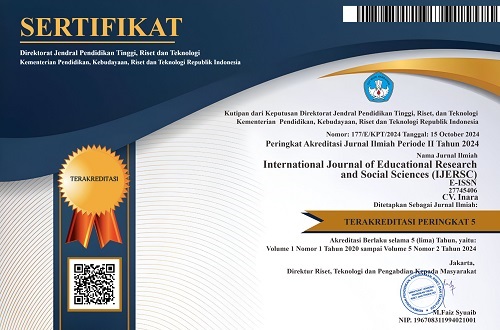Research Trends On Technology-Assisted Child Sexual Abuse: A 20 Years Bibliometric Analysis
DOI:
https://doi.org/10.51601/ijersc.v5i6.930Abstract
Technology-Assisted Child Sexual Abuse (TA-CSA) is a critical issue. This study examines the trends of TA-CSA studies globally to understand the issues. Bibliometric analysis with VOSviewer was conducted on 840 selected journal articles published in the last 20 years from the Scopus database. Between 2002 and 2023, scientific articles on the subject were published by 89 countries, with the US, UK, and Canada being the top 3 countries with the highest publication in TA-CSA. Authors from the US and UK dominate research related to TA-CSA. Research on CSA is more related to medicine, psychology, and social science. TA-CSA research tends to increase, with the highest increase occurring in 2020. Bibliometric analysis also reveals researchers' concerns and research trends regarding TA-CSA. The consistent presence of clusters focusing on TA-CSA highlights the ongoing and persistent nature of this issue. Research in this area continues to explore various aspects, including the prevalence, risk factors, and the impact on victims. It emphasises policy evaluation and victims' access to and accept various forms of protection and assistance.
Downloads
References
F. Schmidt, S. Bucci, E. Quayle, and F. Varese, “Addressing Technology‐Assisted Child Sexual Abuse During an Initial Clinical Assessment: A modified Delphi Study,” Clin Psychol Psychother, vol. 31, no. 5, Sep. 2024, doi: 10.1002/cpp.3071.
R. J. Peters, “Technology-Facilitated Child Abuse,” in Handbook of Interpersonal Violence and Abuse Across the Lifespan, Cham: Springer International Publishing, 2022, pp. 953–973. doi: 10.1007/978-3-319-89999-2_20.
B. A. Zeyzus Johns, A. R. Casola, O. Rea, N. Skolnik, and S. K. Fidler, “Safe-Guarding Youth from Online Sexual Exploitation in the Digital Era: A Role for Primary Care,” Am J Lifestyle Med, Jul. 2024, doi: 10.1177/15598276241268236.
J. L. McCain, J. H. Herbst, M. Merrill-Francis, L. A. Willis, S. S. Miedema, and J. W. Shortt, “Review of Policies and Practices to Prevent Technology-Facilitated Child Sexual Abuse Within Youth-Serving Organizations in the United States,” J Child Sex Abus, vol. 33, no. 5, pp. 545–564, Jul. 2024, doi: 10.1080/10538712.2024.2381457.
National Center for Missing & Exploited Children (NCMEC), “2021 Reports of Online Exploitation,” 2021. Accessed: Dec. 22, 2024. [Online]. Available: www.missingkids.org
C. Hamilton-Giachritsis, E. Hanson, H. Whittle, F. Alves-Costa, and A. Beech, “Technology assisted child sexual abuse in the UK: Young people’s views on the impact of online sexual abuse,” Child Youth Serv Rev, vol. 119, p. 105451, Dec. 2020, doi: 10.1016/j.childyouth.2020.105451.
K. Chauviré-Geib and J. M. Fegert, “Victims of Technology-Assisted Child Sexual Abuse: A Scoping Review,” Trauma Violence Abuse, vol. 25, no. 2, pp. 1335–1348, Apr. 2024, doi: 10.1177/15248380231178754.
C. Doyle, K. O’Reilly, A. Moorhouse, and G. O’Reilly, “An investigation of healthcare professionals’ perspectives on the role of technology in child sexual abuse,” Journal of Sexual Aggression, pp. 1–19, Jun. 2024, doi: 10.1080/13552600.2024.2365179.
C. Doyle, K. O’Reilly, A. Moorhouse, and G. O’Reilly, “An investigation of healthcare professionals’ perspectives on the role of technology in child sexual abuse,” Journal of Sexual Aggression, pp. 1–19, Jun. 2024, doi: 10.1080/13552600.2024.2365179.
L. Waltman, N. J. van Eck, and E. C. M. Noyons, “A unified approach to mapping and clustering of bibliometric networks,” J Informetr, vol. 4, no. 4, pp. 629–635, Oct. 2010, doi: 10.1016/j.joi.2010.07.002.
N. J. van Eck and L. Waltman, “Text mining and visualization using VOSviewer,” ISSI Newsletter, Sep. 09, 2011.
T. M. Rakhel and P. B. Putera, “Corruption in public procurement: A bibliometric analysis,” COLLNET Journal of Scientometrics and Information Management, vol. 15, no. 2, pp. 397–412, Jul. 2021, doi: 10.1080/09737766.2021.1989990.
I. Anillo, D. Feldman, and T. Kennedy, “A Global Outlook on Child Sexual Abuse and Sexually Explicit Material Online During COVID-19: Trends and Interdisciplinary Prevention Methods,” J Child Sex Abus, vol. 32, no. 8, pp. 921–939, Nov. 2023, doi: 10.1080/10538712.2023.2285960.
V. I. Vieth et al., “Responding to Child Abuse During a Pandemic,” in Handbook of Interpersonal Violence and Abuse Across the Lifespan, Cham: Springer International Publishing, 2022, pp. 1881–1901. doi: 10.1007/978-3-319-89999-2_331.
D. Tener et al., “How does COVID-19 impact intrafamilial child sexual abuse? Comparison analysis of reports by practitioners in Israel and the US,” Child Abuse Negl, vol. 116, p. 104779, Jun. 2021, doi: 10.1016/j.chiabu.2020.104779.
M. Salter, D. Woodlock, and T. Wong, “The sexual politics of technology industry responses to online child sexual exploitation during COVID-19: ‘This pernicious elitism,’” Child Abuse Negl, p. 106559, Nov. 2023, doi: 10.1016/j.chiabu.2023.106559.
F. W. Paulus, A. Bédier, and E. Möhler, “Cybergrooming as digital sexual violence against children and adolescents,” Internist Prax, vol. 66, no. 3, pp. 502–520, 2023.
M. L. Ybarra, M. Diener-West, and P. J. Leaf, “Examining the Overlap in Internet Harassment and School Bullying: Implications for School Intervention,” Journal of Adolescent Health, vol. 41, no. 6, pp. S42–S50, Dec. 2007, doi: 10.1016/j.jadohealth.2007.09.004.
J. Wolak, D. Finkelhor, K. J. Mitchell, and M. L. Ybarra, “Online ‘predators’ and their victims: Myths, realities, and implications for prevention and treatment.,” American Psychologist, vol. 63, no. 2, pp. 111–128, Feb. 2008, doi: 10.1037/0003-066X.63.2.111.
Downloads
Published
How to Cite
Issue
Section
License
Copyright (c) 2024 International Journal of Educational Research & Social Sciences

This work is licensed under a Creative Commons Attribution 4.0 International License.






















